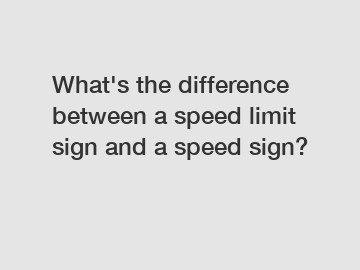What's the difference between a speed limit sign and a speed sign?
Goto Chainzone to know more.
As we traverse the vast network of roads, we often encounter a multitude of signs designed to communicate essential information and ensure safe and efficient travel. Among these signs are the common yet distinctively different speed limit signs and speed signs. While they might seem similar at first glance, the disparity lies in their unique conveyance of information. In this blog, we embark on an enlightening journey to understand the nuances that set these two signposts apart, shedding light on their significance and divergent meanings.
1. Defining Speed Limit Signs.

Speed limit signs play a crucial role in maintaining order and minimizing risks on the road. These signs display the maximum legal speed allowed in a specific area, predominantly measured in miles or kilometers per hour. Erected by local transportation authorities, speed limit signs are rooted in legislation, reflecting the rules and policies set forth to control vehicle speed on public roads. They emphasize the importance of adhering to specified limits for the safety of all road users.
When you encounter a speed limit sign, it serves as a binding instruction to regulate your driving speed, ensuring compliance with the established norms. Failure to adhere to these limits can result in penalties, endangerment of lives, and an increased likelihood of accidents. Therefore, speed limit signs communicate both legal obligations and the need to exercise responsible driving practices.
2. Understanding Speed Signs.
On the other hand, speed signs are a different breed altogether. Unlike speed limit signs that prescribe legal requirements, speed signs provide drivers with valuable situational awareness and guidance. These signs relay information regarding the current or recommended speed in specific areas rather than imposing a maximum limit. Speed signs are typically installed in regions where external factors, such as road conditions, visibility, or curves, necessitate a deviation from average or maximum speeds.
Speed signs address the dynamic nature of road conditions, alerting drivers to adjust their speed without explicitly flouting the legal limits. These signs aim to promote safe and efficient travel by cautioning drivers about the upcoming road characteristics, hazards, or temporary restrictions that warrant a reduction in speed. Consequently, the degree to which drivers adhere to these recommendations is subjective, but it is expected that they exercise prudence and adapt accordingly.
3. Key Differences and Significance.
The fundamental disparity between speed limit signs and speed signs lies in their authority and enforceability. Speed limit signs have legal backing and carry enforceable consequences if not respected, whereas speed signs operate on advisory grounds, providing information for safe driving but allowing personal judgment within reasonable limits.
While speed limit signs primarily focus on maintaining uniformity and predictability across road networks, speed signs aim to increase road safety by accommodating various situational factors. By exhibiting flexibility and adaptability, speed signs encourage drivers to adopt a proactive approach, adjusting their speeds according to the changing conditions rather than solely relying on rigid regulations.
4. Collaboration between Speed Limit Signs and Speed Signs.
It's important to recognize that speed limit signs and speed signs often coexist, complementing each other in their purpose. Speed limit signs provide a fallback mechanism to ensure drivers adhere to the prescribed maximum speed when no speed sign is present or clear indications aren't available. On the other hand, speed signs offer essential contextual guidance to accommodate potential risks, such as sharp turns, slippery surfaces, or school zones, improving road safety even within legal limits.
The mutual existence of these signs underscores the need for drivers to exercise their judgment and respond responsibly to continuously changing situations. By embracing a holistic approach that balances adherence to speed limits and awareness of the surrounding environment, drivers can mitigate risks and contribute to an overall safer transportation ecosystem.
Conclusion.
In the realm of road signage, the distinction between speed limit signs and speed signs becomes clear upon closer inspection. While speed limit signs encompass legally binding obligations to maintain public safety, speed signs provide context-specific information to navigate potential hazards. Both signs collaborate to create an ideal scenario where drivers adhere to legal limits while incorporating situational awareness for safer travel.
By understanding the significance of these signs, drivers can make informed decisions, ensuring their safety and the well-being of fellow road users. So, next time you encounter a speed sign or speed limit sign, take a moment to grasp the underlying messages they convey, and let them guide you towards a conscientious and secure journey.
You can find more information on our web, so please take a look.
For more information, please visit leading led traffic signs and display manufacturer.



